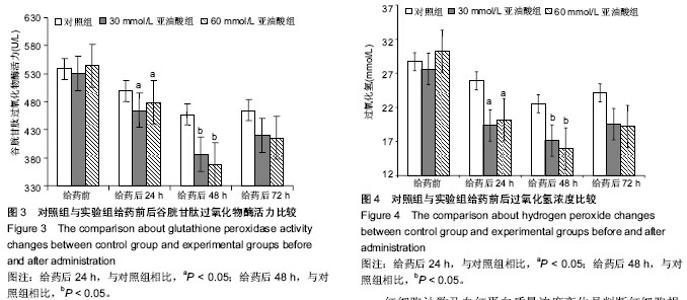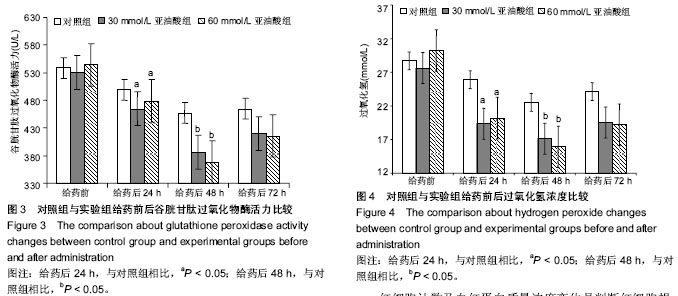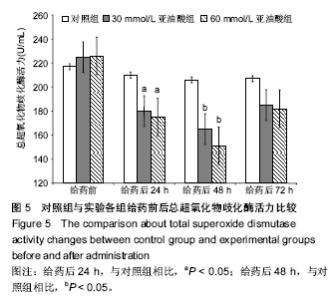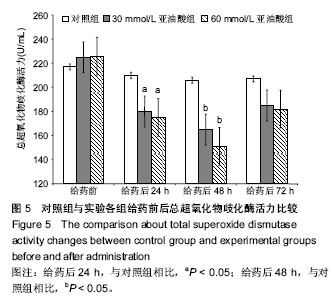Chinese Journal of Tissue Engineering Research ›› 2014, Vol. 18 ›› Issue (48): 7739-7744.doi: 10.3969/j.issn.2095-4344.2014.48.006
Previous Articles Next Articles
Linoleic acid and acute red blood cells injury: mechanism of hidden blood loss after artificial joint replacement
Yuan Tao1, Cong Yu2, Zhao Jian-ning1, 2, Zhou Li-wu2, Chen Shuang-shuang3, Bao Ni-rong2
- 1Department of Orthopedics, Nanjing School of Clinical Medicine, Southern Medical University, Nanjing General Hospital of Nanjing Military Region of Chinese PLA, Nanjing 210002, Jiangsu Province, China; 2Department of Orthopedics, Nanjing General Hospital of Nanjing Military Region of Chinese PLA, Nanjing 210002, Jiangsu Province, China; 3Department of Ophthalmology, the 455 Hospital of Chinese PLA, Shanghai 200050, China
-
Received:2014-09-19Online:2014-11-26Published:2014-11-26 -
About author:Yuan Tao, Studying for master’s degree, Department of Orthopedics, Nanjing School of Clinical Medicine, Southern Medical University, Nanjing General Hospital of Nanjing Military Region of Chinese PLA, Nanjing 210002, Jiangsu Province, China -
Supported by:Clinical Science and Technology Foundation of Jiangsu Province, No. L2012002; Natural Science Foundation of Jiangsu Province, No. BK2012776
CLC Number:
Cite this article
Yuan Tao, Cong Yu, Zhao Jian-ning, Zhou Li-wu, Chen Shuang-shuang, Bao Ni-rong. Linoleic acid and acute red blood cells injury: mechanism of hidden blood loss after artificial joint replacement[J]. Chinese Journal of Tissue Engineering Research, 2014, 18(48): 7739-7744.
share this article
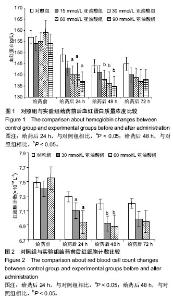
2.1 实验动物数量分析 1个对照组和4个实验组共50只大鼠纳入实验,其中90 mmol/L亚油酸组大鼠中有5只大鼠在实验过程中于给药后几分钟死亡,其他各组大鼠均顺利采集样本,并对所有样本进行血红蛋白质量浓度和红细胞计数检测,采集数据。对各组样本的数据分析发现 30 mmol/L亚油酸组、60 mmol/L亚油酸组大鼠血红蛋白质量浓度和红细胞计数发生了显著变化,考虑发生了隐性失血,然后进一步检测分析对照组、30 mmol/L亚油酸组、60 mmol/L亚油酸组大鼠血液中谷胱甘肽过氧化物酶活力、总超氧化物歧化酶活力以及过氧化氢浓度的变化情况,探究隐性失血的机制。 2.2 结果分析 实验组通过尾静脉给予不同的药物浓度,成功建立了大鼠隐性失血的模型,随着药物浓度的增加实验组红细胞计数及血红蛋白质量浓度变化愈加明显,当药物浓度为90 mmol/L时,半数大鼠发生死亡,主要表现为呼吸困难、口唇发绀、咯血、抽搐直至死亡,致死原因为肺栓塞。研究数据表明当药物浓度为60 mmol/L血红蛋白质量浓度变化显著(P < 0.05,图1)。 对照组、亚油酸30 mmol/L组和60 mmol/L组血液样本做进一步检验分析。在给药前,各组大鼠体质量及血液检测指标之间无明显差异。给药后24 h,对照组及实验组血液中血红蛋白质量浓度、红细胞计数均有明显的下降(图1,2),对照组下降分别约(8.5±2.3) g/L,(0.22±0.05)×1012 L-1,亚油酸组下降约(16.5±2.0) g/L,(0.65±0.15)×1012 L-1,实验组与对照组相比变化更明显(P < 0.05);对照组和实验组中的谷胱甘肽过氧化物酶活力、总超氧化物歧化酶活力、过氧化氢浓度均明显下降且实验组变化更显著(P < 0.05, 图3-5)。 给药后48 h,实验组及对照组血液中的红细胞计数、血红蛋白质量浓度与给药后24 h相比变化差异均无显著"
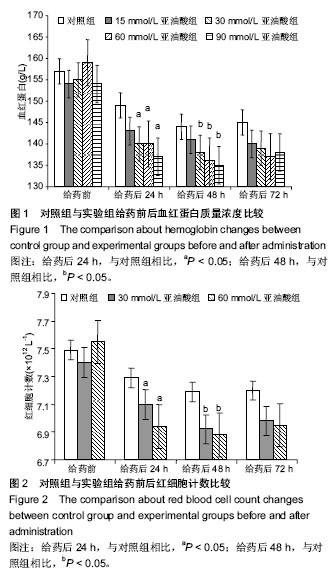
| [1] Qian M, Eaton JM. Free fatty acids enhance hypochlorous acid production by activated neutrophils. J Lab Clin Med. 1994;124(1): 86-95. [2] Cortes-Rojo C, Fernández-Quintero M, Aguilar-Toral R, et al. Accelerated chronologic aging of S. cerevisiae induced by PUFA is associated to mitochondrial dysfunction, enhanced sensitivity to lipid peroxidation and ROS overproduction. FASEB J. 2013;27: 833. [3] Bao N, Meng J, Zhou L, et al. Lesser trochanteric osteotomy in total hip arthroplasty for treating CROWE type IV developmental dysplasia of hip. Int Orthop. 2013;37(3): 385-390. [4] Nie G. Quantization Determination Study of Micro-Raman Spectroscopy of Methemoglobin Induced by Sodium Nitrite. Guang Pu Xue Yu Guang Pu Fen Xi. 2013;33(7): 1805-1809. [5] Lu N, Chen P, Yang Q, et al. Anti-and pro-oxidant effects of (+)-catechin on hemoglobin-induced protein oxidative damage. Toxicol Vitro. 2011;25(4): 833-838. [6] Potor L, Bányai E, Becs G, et al. Atherogenesis may involve the prooxidant and proinflammatory effects of ferryl hemoglobin. Oxid Med Cell Longev. 2013. [7] Pandey KB, Rizvi SI. Anti-oxidative action of resveratrol: Implications for human health. Arab J Chem. 2011;4(3): 293-298. [8] de M Bandeira S, da Fonseca LJS, da S Guedes G, et al. Oxidative stress as an underlying contributor in the development of chronic complications in diabetes mellitus. Int J Mol Sci. 2013;14(2): 3265-3284. [9] Celedón G, González G, Gulppi F, et al. Effect of Human Serum Albumin Upon the Permeabilizing Activity of Sticholysin II, a Pore Forming Toxin from Stichodactyla heliantus. Protein J. 2013;32(8): 593-600. [10] 李少斐,郭亭,赵建宁,等.围髋关节置换期隐性失血相关危险因素及预后[J].中国组织工程研究,2014,18(13): 2006-2011. [11] 刘志刚,张上上,陈如见,等.全髋关节置换后的隐性失血[J].中国组织工程研究,2013,17(13): 2305-2312. [12] Horstmann WG, Kuipers BM, Slappendel R, et al. Postoperative autologous blood transfusion drain or no drain in primary total hip arthroplasty? A randomised controlled trial. Int Orthop. 2012;36(10): 2033-2039. [13] Koessler MJ,Fabiani R,Hamer H,et al. The clinical relevance of embolic events detected by transesophageal echocardiography during cemented total hip arthroplasty: a randomized clinical trial. Anesth Analg. 2001;92(1): 49-55. [14] Pattison E,Protheroe K,Pringle RM, et al. Reduction in haemoglobin after knee joint surgery. Ann Rheum Dis. 1973; 32(6): 582. [15] Haien Z,Yong J, Baoan M, et al. Post-operative auto-transfusion in total hip or knee arthroplasty: a meta-analysis of randomized controlled trials. PloS One. 2013; 8(1): e55073. [16] Monsef JB, Buckup J, Waldstein W, et al. Fibrin sealants or cell saver eliminate the need for autologous blood donation in anemic patients undergoing primary total knee arthroplasty. Arch Orthop Trauma Surg. 2014;134(1): 53-58. [17] Barge S,Donadee C,Triulzi D,et al. Acute Effect Of Autologous Blood Transfusion On The Venous Level Of Hemolysis Markers Am J Respir Crit Care Med. 2013;187: A4681. [18] Hatanaka E, Levada-Pires AC, Pithon-Curi TC, et al. Systematic study on ROS production induced by oleic, linoleic, and gamma-linolenic acids in human and rat neutrophils.Free. Radic Biol Med. 2006;41(7):1124-1132. [19] Shen H, Li Z, Feng M, et al. Analysis on hidden blood loss of total knee arthroplasty in treating knee osteoarthritis. Chin Med J. 2011;124(11): 1653. [20] Tetro AM, Rudan JF. The effects of a pneumatic tourniquet on blood loss in total knee arthroplasty. Can J Surg. 2001; 44: 33-38. [21] Du Z, Liu P, Zhang Y, et al. Effect of tourniquet on perioperative blood loss and short-term effectiveness in total knee arthroplasty.Zhongguo Xiu Fu Chong Jian Wai Ke Za Zhi. 2013;27(11):1318-1323. [22] 马卫华,张树栋,王诗军,等.止血带的使用方式对膝关节置换术失血量和手术时间的影响[J].中华关节外科杂志,2012,5(6): 33-36. [23] Li B, Wen Y, Wu H, et al. The effect of tourniquet use on hidden blood loss in total knee arthroplasty. Int Orthop. 2009; 33(5): 1263-1268. [24] Sehat KR, Evans RL, Newman JH. Hidden blood loss following hip and knee arthroplasty correct management of blood loss should take hidden loss into account. J Bone Joint Surg. 2004;86(4): 561-565. [25] 刘志刚,张上上,陈如见,等.全髋关节置换后的隐性失血[J].中国组织工程研究,2013,17(13): 2305-2312. [26] Kaikkonen JE, Kresanov P, Ahotupa M, et al. High serum n6 fatty acid proportion is associated with lowered LDL oxidation and inflammation: The Cardiovascular Risk in Young Finns Study. Free Rad Res. 2014;48(4): 420-426. [27] Pratt DA, Tallman KA, Porter NA. Free radical oxidation of polyunsaturated lipids: new mechanistic insights and the development of peroxyl radical clocks. Acc Chem Res. 2011; 44(6): 458-467. [28] Nowak JZ. Oxidative stress, polyunsaturated fatty acidsderived oxidation products and bisretinoids as potential inducers of CNS diseases: focus on age-related macular degeneration. Pharmacol Rep. 2013;65(2): 288-304. [29] Jomova K, Baros S, Valko M. Redox active metal-induced oxidative stress in biological systems. Trans Met Chem. 2012; 37(2): 127-134. [30] Beavers WN, Serwa R, Shimozu Y, et al. ω-Alkynyl Lipid Surrogates for Polyunsaturated Fatty Acids: Free Radical and Enzymatic Oxidations. J Ame Chem Soc. 2014. [31] Nowak JZ. Oxidative stress, polyunsaturated fatty acidsderived oxidation products and bisretinoids as potential inducers of CNS diseases: focus on age-related macular degeneration. Pharmacol Rep. 2013;65(2): 288-304. [32] Zhang M, Wang A, He W, et al. Effects of fluoride on the expression of NCAM, oxidative stress, and apoptosis in primary cultured hippocampal neurons. Toxicology. 2007; 236(3): 208-216. [33] Gao Y, Guo YK, Lin SH, et al. Hydrogen peroxide pretreatment alters the activity of antioxidant enzymes and protects chloroplast ultrastructure in heat-stressed cucumber leaves. Scientia Horticul. 2010;126(1): 20-26. [34] Ahmida MHS. Protective role of curcumin in nephrotoxic oxidative damage induced by vancomycin in rats. Exp Toxicol Pathol. 2012;64(3): 149-153. [35] Wang HF, Zhong XH, Shi W, et al. Study of malondialdehyde (MDA) content, superoxide dismutase (SOD) and glutathione peroxidase (GSH-PX) activities in chickens infected with avian infectious bronchitis virus. Af J Biotechnol. 2013;10(45): 9213-9217. [36] Liu J, Wen X, Lu J, et al. Free radical mediated grafting of chitosan with caffeic and ferulic acids: Structures and antioxidant activity. Int J Biol Macromol. 2014;65: 97-106. [37] Chen H, Liu L, Zhu J, et al. Effect of soybean oligosaccharides on blood lipid, glucose levels and antioxidant enzymes activity in high fat rats. Food Chem. 2010;119(4): 1633-1636. [38] Rolo AP, Teodoro JS, Palmeira CM. Role of oxidative stress in the pathogenesis of nonalcoholic steatohepatitis. Free Rad Biol Med. 2012; 52(1): 59-69. [39] de M Bandeira S, da Fonseca LJS, da S Guedes G, et al. Oxidative stress as an underlying contributor in the development of chronic complications in diabetes mellitus. Int J Mol Sci. 2013; 14(2): 3265-3284. [40] 王雪艳,匡洪宇.糖尿病与糖尿病肾病患者氧化应激状态的分析[J]. 齐齐哈尔医学院学报,2008, 29(6): 694-694. [41] Kie?-Wilk B, Ma?ecki M, Gruca A, et al. Dietary Supplements and Herbs in Diabetes and Its Prevention. Bioactive Food as Dietary Interventions for Diabetes: Bioactive Foods in Chronic Disease States, 2012: 121. |
| [1] | Zhou Qi, Gao Yi, Wei Kang, Li Jun, Xu Jianda, Jiang Yang, Qu Yuxing. Total knee arthroplasty for rheumatoid arthritis: knee function and biochemical index changes [J]. Chinese Journal of Tissue Engineering Research, 2020, 24(9): 1337-1341. |
| [2] | Qiao Jiutao, Guan Dehong, Wang Dongyan, Liu Aiyun. Zuogui Pill has protective effect against oxidative stress injury in osteoblasts [J]. Chinese Journal of Tissue Engineering Research, 2020, 24(7): 1052-1056. |
| [3] | Bai Zhenjun, Liu Tong, Wang Zirun, Zhang Huiyu, Xu Peng. Effect of “Lumbar Three Needles” on expression of oxidative stress factors in rats with multifidus muscles injury [J]. Chinese Journal of Tissue Engineering Research, 2020, 24(32): 5145-5150. |
| [4] | Cao Houran, Deng Peng, Ye Pengcheng, Jie Ke, Zeng Jianchun, Feng Wenjun, Chen Jinlun, Qi Xinyu, Li Jie, Tan Xueqiu, Zhang Haitao, Zeng Yirong. Platelet count as a novel potential predictor of periprosthetic joint infection [J]. Chinese Journal of Tissue Engineering Research, 2020, 24(30): 4795-4801. |
| [5] | Li Zifei, Wang Qian, Luan Jie, Mu Dali, Liu Chunjun, Xin Minqiang, Fu Su, Xu Boyang, Liu Wenyue, Chen Lin, Cheng Hao, Wang Chenglong, Kang Deni, Li Shangshan, Qi Jun. Ammonium chloride lysis method versus non-lysis method for isolation of human adipose-derived stem cells [J]. Chinese Journal of Tissue Engineering Research, 2020, 24(1): 45-50. |
| [6] | Ma Jie, Ji Linhua, Li Zhanquan, Liu Huihui, Ma Lan, Xi Rui, Cui Sen. Changes of peripheral and bone marrow erythrocytes in plateau pikas and rats after hypoxia exposure [J]. Chinese Journal of Tissue Engineering Research, 2020, 24(1): 112-117. |
| [7] | Cao Haixin, Wang Xiaomei. Rhodiola intervention improves mitochondrial autophagy and fusion-division in skeletal muscle cells of mice with high intensity exercise [J]. Chinese Journal of Tissue Engineering Research, 2020, 24(1): 136-140. |
| [8] | Wang Changbing1, 2, Lu Mingfeng2, He Lilei2, Xing Jisi2, Xu Ting2, Zhao Lilian2, Liu Xiaofang1 . Diagnosis and treatment of early joint infection after anterior cruciate ligament reconstruction [J]. Chinese Journal of Tissue Engineering Research, 2019, 23(35): 5592-5599. |
| [9] | Liu Zhiyuan1, Zhang Jinying2, Liu Jiangbo1, Zhao Xiaoning1, Liu Fei1, Li Gang1. Prourokinase combined with non-invasive delayed limb ischemic preconditioning in rat models of myocardial ischemia/reperfusion injury [J]. Chinese Journal of Tissue Engineering Research, 2019, 23(35): 5626-5632. |
| [10] | Meng Qingxi1, Wang Weiheng2, Sun Aijun3, Xi Yanhai1, Ye Xiaojian1. Protective effects of methane saturated saline on endotoxin-induced acute lung injury in rats [J]. Chinese Journal of Tissue Engineering Research, 2019, 23(3): 396-403. |
| [11] | Wang Jiaojie, An Huijuan, Shan Hong, Han Xiaogai, Bie Lili, Li Jianbin. Induced differentiation of peripheral blood hematopoietic stem cells into mature erythrocytes in vitro [J]. Chinese Journal of Tissue Engineering Research, 2019, 23(29): 4662-4667. |
| [12] | Yang Kaiye, Wang Liping, Wang Bingxin, Lu Yingyu, Feng Jiao, Wu Meiyin, Shi Wan, Hou Shaozhen. Inhibitory effect of complex polysaccharides on ultraviolet-induced photoaging of skin cells [J]. Chinese Journal of Tissue Engineering Research, 2019, 23(29): 4707-4713. |
| [13] | Zang Wenhao, Song Jian, Teng Xueren, Zhang Qiliang. Correlation of local skin temperature of knee joint with C-reactive protein, interleukin 6 and erythrocyte sedimentation rate after primary unilateral total knee arthroplasty [J]. Chinese Journal of Tissue Engineering Research, 2019, 23(24): 3773-3779. |
| [14] | Zhao Chong-yu, Wang Bing, Lou Zhen-kai, Li Xing-guo, He Wei, Zhao Xue-ling. Expression levels of SIRT1 and oxidative stress injury markers in a mouse model of deep venous thrombosis [J]. Chinese Journal of Tissue Engineering Research, 2018, 22(28): 4518-4524. |
| [15] | Jiang Yan1, Wu Di1, Wu Feng-yu2. Changes in the skeletal muscle morphology and supercompensation after different intensities of training under aerobic energy supply [J]. Chinese Journal of Tissue Engineering Research, 2018, 22(24): 3811-3817. |
| Viewed | ||||||
|
Full text |
|
|||||
|
Abstract |
|
|||||
